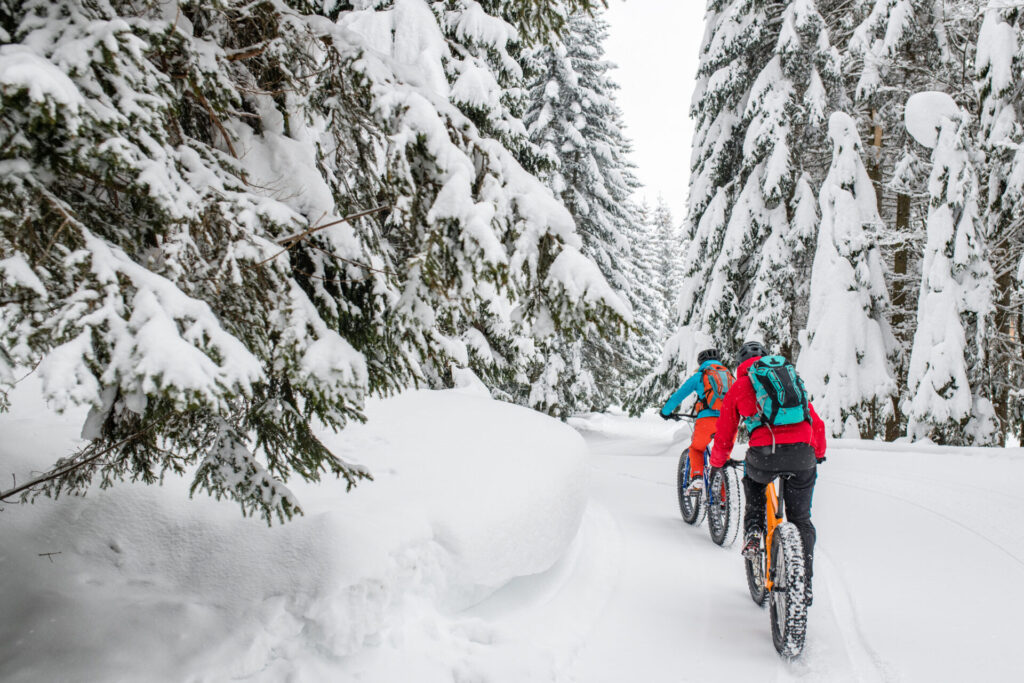You enjoyed cycling all summer, gliding over trails and paths, the wind flowing through the holes in your helmet. But once the snow flies, your cycling dreams disappear…or do they?
Despite snow and slush on the roads, winter biking continues to gain adventurous and hardy fans of biking. If getting out on two wheels all year long appeals to you, there are a few key things to consider staying warm and safe.
Whether you’re new to two-wheeling on snow-covered streets or are looking for a few tips to make it more enjoyable, we’ve got you covered with six great ways to help you enjoy your ride at sub-zero.
Bike care
The winter can be hard on your bike. But with extra maintenance and care, you can ensure it stays in shape.
Road salt, gravel and other things used as de-icers can wreak havoc on a bike chain and all moving parts. Be sure to regularly rinse off your bike to avoid rusting and corrosion and to ensure slush and ice don’t freeze and jam up the chain. Use a low-pressure hose or rag and a bucket of warm water to rinse your bike.
Remember that road salt is at its most corrosive when temperatures rise above 0°C, so make sure to give your bike a thorough cleaning at the end of the winter season.
After cleaning your bike, re-lube your chain and gear system to keep your bike working for years to come! Try a dry lube for winter. It can help reduce the debris and slush that can build up in your bike’s chain and gears.
Helpful gear
While your regular bike is just fine for snowy roads, there are some gear upgrades you can consider, like installing thicker tires. The wide tread can improve traction and mobility, helping you stay safe.
If you are purchasing a bike for winter use only, choose one with a heavier frame and thick tires.
For the icy streets, install studded tires for some assistance moving over ice.
You’ll also want to pick up some fenders to keep dry from the wet snow and slush. A fender that fits closely over your bike’s tires will help stop you and the people nearby from getting sprayed with slush from your tires. Plus, clip-on options make it easy to clean out any slush or ice build-up.
Stay visible
Did you know that it is the law in Ontario for bikes to have a white front light, in addition to a red light or a reflector, from a half hour after dusk till before dawn? The lights will help you stay visible, especially when conditions and visibility are poor.
When it is dark, make sure to wear bright and reflective clothing. Plus, add reflectors to your pedals and around your ankles. And, with the sun setting early, keep your bike lights handy just in case you get caught in the dark. Some winter cyclists ride with their lights on during the day in case of snow or poor visibility.
Take your time
Make sure you take your time and go slow. Just like driving, stopping your bicycle in icy conditions can be tricky. So be sure to break well in advance to avoid sliding. On turns, proceed with caution and slow down to prevent spills. And beware of black ice.
When biking alongside vehicles this winter, be extra careful. Drivers miss seeing cyclists on the roads this winter. Plus, when snow builds up, bike lanes can have less room.
Be smart about when and where you ride. Check the weather forecast before heading out, and dress accordingly. Paved trails are easier to ride and navigate in the winter than unpaved ones and drain faster.
Layer up
Winter biking is a great way to get around and exercise. The cold-weather gear you already own is all you need to stay warm.
Your body temperature may be hard to regulate when cycling. You’ll start cold and get warmer as you go.
Start with a warm base layer, then a middle layer and top it all off with a zip-up jacket that can be removed and has ventilation to stop you from sweating. Waterproof outer layers are critical for a comfortable ride through winter snow and slush.
Stay warm
Remember that hands and feet are the first to get cold. So protect your extremities with a warm pair of waterproof gloves and boots. Want to avoid investing in a new pair of waterproof boots to stay warm? Then try out waterproof boot covers.
Don’t forget to cover your head. A thin toque or headband that fits under your helmet will help keep you toasty. Also consider a ski mask or buff to protect your neck and face for those extremely cold or snowy winter days. Finally, grab a pair of clear glasses or ski goggles to keep the snow from your eyes.
If you do get stuck in the snow, don’t forget your CAA Membership. CAA’s Bike Assist will come to your rescue this winter.


